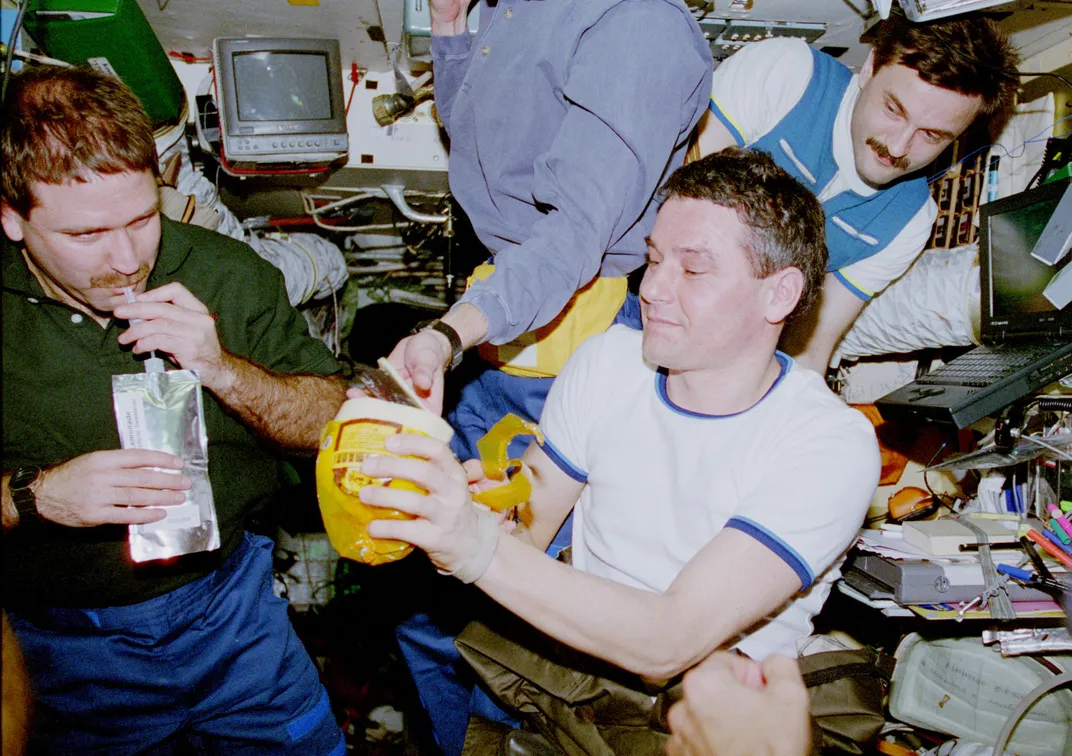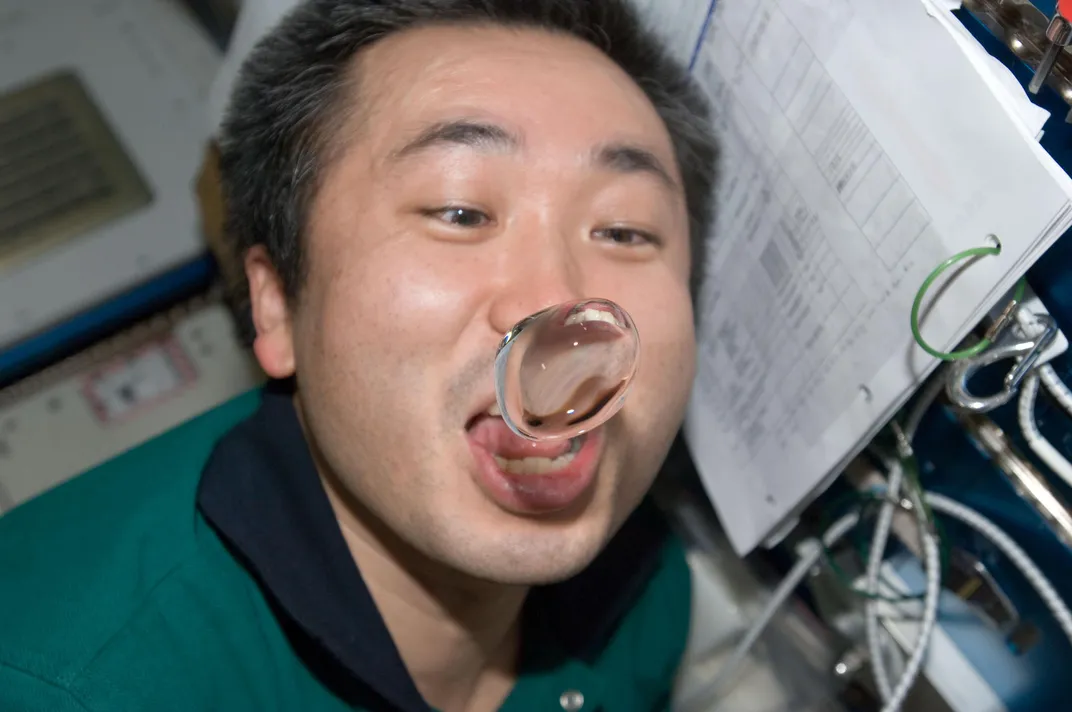How to Drink Cognac in Space
On the Russian Mir space station, alcohol came in small, floating spheres, best drunk with a straw.
:focal(1342x699:1343x700)/https://tf-cmsv2-smithsonianmag-media.s3.amazonaws.com/filer/38/b9/38b9cded-3b06-498f-953b-9facb93d68bb/christmas_on_mir.jpg)
In his new book, Alcohol in Space: Past, Present and Future, Chris Carberry chronicles the history of extraterrestrial drinking, from the first mini-bottle sneaked onboard a Mercury capsule to the present. The following condensed excerpt covers the years onboard Mir, the predecessor of today’s International Space Station.
Perhaps no other orbiting facility or spacecraft attained a more impressive reputation for cosmic drinking than the Russian Mir space station of the late 1980s and 1990s. While Russian policy officially prohibited them, alcoholic beverages—specifically cognac—were regularly smuggled aboard. For many Russians, it was seen as an important element in crew relaxation and socialization.
According to cosmonaut Alexander Lazutkin, “During prolonged space missions, especially at the beginning of the space age, we had alcoholic drinks in the cosmonauts’ rations.” Russian doctors had recommended cognac to stimulate their “immune system and on the whole to keep our organisms in tone.”
Despite the official restrictions, Russian support personnel and Russian management were well aware that alcoholic beverages were being launched to Mir. Jeffrey Manber, who today is CEO of the space logistics company Nanoracks, worked in the 1990s for Energia, the legendary company that is the prime contractor for the Russian human spaceflight program.
During his time in Russia, the Shuttle-Mir program was established as a partnership between the United States and Russia. The Space Shuttle would ferry astronauts to and from Mir, allowing American astronauts to conduct long-term expeditions onboard that facility. As part of the deal, American astronauts would also fly on Russian Soyuz spacecraft.
It was the first partnership in space between the former cold war adversaries since the Apollo-Soyuz Test project in 1975, and, recalls Manber, “We instantly ran into some cultural differences.” One was the policy regarding the use of alcohol onboard the station. “The Russian and European side of the program—then principally men—were up there 24/7, and come Saturday they [had] a day off and they would have some cognac or some vodka and watch some movies or read a book or just chill on a Saturday.”
Manber recalled that NASA was “absolutely aghast” that alcoholic beverages were commonly present on Mir. While crew members would only have small amounts of cognac, no more than once a week after a hard day of work, this practice ran counter to NASA policy and philosophy on temperance in space. According to Manber, NASA raised their concerns with the Russians and Europeans—particularly the French. Both countries share a far more relaxed view on the role of alcohol in society as well as in space.
As Manber explains, for the French, consumption of alcohol is an extension of their culture. “They have lovely cognac—I tried it. They worked very hard in the 90s to have high quality French food on the Mir space station. They brought in chefs who worked hard to make sure that the Foie Gras or even the basic food was good—and tasty.” The French did not want their astronauts—their national heroes—only eating standard astronaut rations. “They wanted to treat them with French food and French cognac and other little delectables from France,” Manber explained.

Despite American conflicted attitudes regarding alcohol in society and in space, NASA astronauts on Mir were often willing participants in toasts or celebrations involving the obligatory cognac. On Space Shuttle mission STS-81 in 1997, astronaut John Grunsfeld fondly remembers being invited to Mir for a social gathering. “About mid-mission, while docked to the Mir space station, we were invited over to the Mir for a social event,” he recalled. “When we were over there Valeri [Korzun] came up with a little bottle. And someone asked ‘Oh, is that vodka?’ and Valeri said, ‘No. no. We would never carry vodka to space. It’s cognac.’ ”
According to Grunsfeld, fine cognac came up to Mir in the medical kit delivered by Progress supply ships. “It was fascinating because what he did was—these were tiny little bottles with no more than 250 milliliters. Just gave it a tiny squeeze and out came a singular ball, a round sphere, of cognac floating in the cabin. He gave each crew member a tiny little ball of cognac—no more than 25 milliliters each. It was a nice event, and as far as I know, nobody got drunk at it.”
Grunsfeld fully understands NASA’s reluctance to accept any level of alcohol consumption on space missions, but also believes that moving forward—when humans are away from Earth for longer durations—these rules may have to be adjusted. “Properly managed, I don’t think there is any real problem. Once you start living in space, I’m not sure there’s any real hazard there over and above the tremendous hazard of space.”
Grunsfeld was not the only one who enjoyed these rituals aboard Mir. Michael Foale, a British/American astronaut, visited Mir in 1997 and appears to have been perfectly comfortable imbibing occasionally, “Eating and drinking in space is more fun than on Earth. It is like camping: the social aspect of it is really important....Even though the food is not great, it tastes good enough.” Foale continued, “Same with drinking. If there is just a tiny little bit of alcohol on a station, boy, you enjoy that.”
As always, the available drink was cognac. “You suck up a few drops with a straw and it spreads around the inside of your mouth and a bit up your nose because there is no gravity to pull it into your throat….The alcohol gets absorbed quite instantly, like a cigarette draw where you get the instant buzz. Then, as it goes down your throat, you eventually get that warm feeling.”

The cognac did not always remain on Mir, however. In fact, on at least one occasion it traveled over to the Space Shuttle when the Americans were docked at Mir. In a NASA oral history covering his time on Mir, astronaut Norman Thagard described an occasion when he and some of his fellow astronauts and cosmonauts had a drink on the Shuttle. Aware of the sensitivities of this topic, he told the interviewer, “I probably might not even ought to say this, but I will anyhow, because what can they do, sue us at this point?” Thagard’s 52nd birthday occurred when the Shuttle was docked to Mir, and to commemorate the event the Russians gave him a “really good Russian cognac.”
The cognac had originally been purchased for a party that had taken place before the launch in Russia, but a large quantity remained unconsumed. Thagard and some of his Russian colleagues “decanted” the remaining drink into plastic containers and wrapped the containers tightly with tape. According to Thagard, “We labeled them all ‘juice,’ and they carried them out and put them in the Soyuz. So, we launched with quite a lot of cognac on the Soyuz.”
After his NASA colleagues arrived on the Shuttle, Thagard and fellow astronaut Charles Precourt, as well as cosmonauts Vladimir Dezhurov (Veloga) and Gennady Strekalov, all went to the Spacelab module located in the cargo bay of the Shuttle. However, Thagard thought that they could not all disappear to Spacelab without notifying Shuttle mission commander Hoot Gibson. Thagard approached Gibson and said “Hoot, I just want to tell you that…” Apparently Gibson anticipated the question, because he replied with a laugh, “I don't want to know about it.”
“Between the four of us we had a fifth of cognac, but I never saw anybody drunk,” recalled Thagard. “In fact, I never saw anybody drink more than what I would consider to be one shot.…We all had our straws, and we would take straws and we would stick them down into one of the bubbles and just take a sip, and then you would gently push the bottle and it would float over to the next person, and they'd put their straw in.”
By all accounts, the Mir space station was a highly stressful environment, and the cosmonaut and astronaut crews experienced a couple of near disasters, including an onboard fire and a collision with a docking cargo ship a few months later. It is doubtful whether the presence of alcohol was in any way related to these incidents. But when the press reported that there was cognac onboard Mir, various news stories seemed to imply that it was part of the problem, and the sobriety of the Russian cosmonauts was called into question.
Despite this bad press, what is clear is that cognac played an important ceremonial role in helping to create bonds between crew members from the United States and Russia. This contribution should not be dismissed, since it came at a critical time for space exploration and for relations between the two rival superpowers. One certainly cannot conclude that providing liquor in space is always a good policy, but it helped pave the way for the partnership that resulted in today’s International Space Station.
From Alcohol in Space: Past, Present and Future © 2019 by Chris Carberry. Reprinted by permission of McFarland publishing.